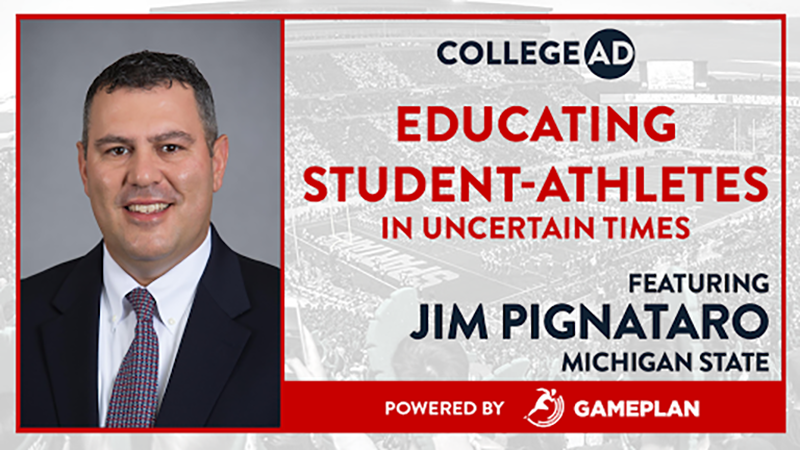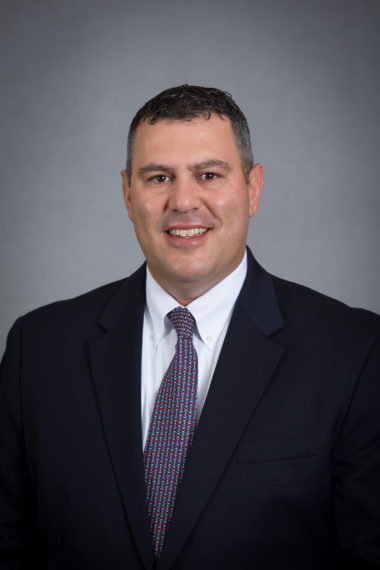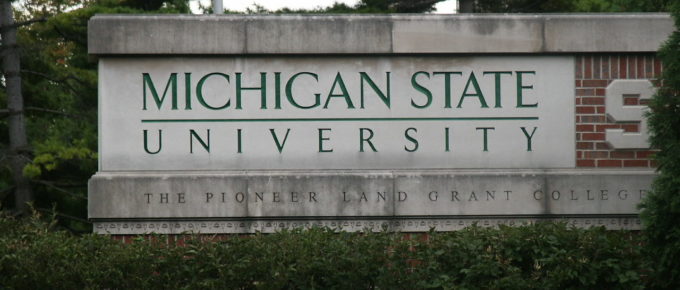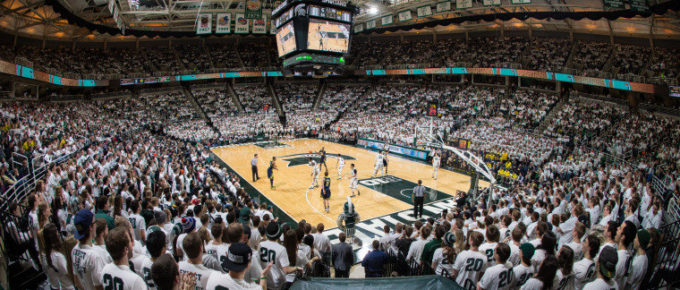
“We had to flip a lot of what we were doing on its head. In the past, we were delivering much of our student-athlete development in person. We had to make an adjustment, and switch to virtual programming, in just about everything.” -Jim Pignataro
Jim Pignataro has held multiple roles at Michigan State University, the latest hat he wears is Executive Associate Athletic Director for Student-Athlete Services. A role that became crucial during the current crisis.
 “In my role here, I wear multiple hats. I assist our leaders in student-athlete development and engagement areas, medical services, mental health, nutrition, academics, and athletic performance. We have a wonderful team of people that put together programs to assist our student-athlete’s transition from high school and beyond. Over 10 years ago we were fortunate to be on the front end of what Game Plan was providing to student-athletes. We used platforms to drive career programming both in-person and virtual. Now here we are over a decade later leaning more than ever on these services that have been put in place.”
“In my role here, I wear multiple hats. I assist our leaders in student-athlete development and engagement areas, medical services, mental health, nutrition, academics, and athletic performance. We have a wonderful team of people that put together programs to assist our student-athlete’s transition from high school and beyond. Over 10 years ago we were fortunate to be on the front end of what Game Plan was providing to student-athletes. We used platforms to drive career programming both in-person and virtual. Now here we are over a decade later leaning more than ever on these services that have been put in place.”
Pignataro says that even with the foundations in place, it was still a challenge to take everything into the virtual space.
“Especially for those of us that rely on our people skills to make that impression, it’s a challenge to make those same connections in the virtual space. For example, our advising and tutorial services had to move to online. Those services had not been offered virtually, so it was a challenge. Within several days everything had to transition and our staff did a wonderful job. The whole industry had to adjust.”
He explains getting on to Zoom wasn’t necessarily the hard part, rather protecting the academic integrity of the program, which is the top priority.
“Throughout the industry we discuss how, in some cases, the quality of services may have improved. As a student or professional you have to come into the virtual session very prepared, it’s not as social, it’s more rigid. It was fascinating to watch the services take shape.”
Pignataro says that early in the process some of our services, like student-athletes development programming, had to be put on hold, at first, but then they began to lean on educational services and platforms to connect with student-athletes in ways MSU had not done in the past.
“A good example is our nutritional programming. We were able to access online content and push out content and video that they provide. We were able to pivot right away to provide those services online. It was exciting that we were able to do that. A student that may have started their day by seeing a medical professional then going to tutoring, etc. They now did all of that online. Some students struggled and some excelled at it. Our staff to be very in-tune and very aware of our student-athletes were responding to that.”

The staff at Michigan State had to constantly monitor the situation and adapt. Jim Pignataro says that one of the bigger challenges was the nutritional component.
“If I’m meeting with a tutor, I can recreate that online. But a tangible product like food and nutrition is very difficult to do. In the beginning, they were going home, so the video content and educating them on what choices to make and even how to cook at home. Now that there are programs back on campus, it’s now grab and go food from restaurants. That might be the new normal for a while, utilizing the community sources for food products.”
Besides the challenges of taking services online, Jim Pignataro and his staff have also had to navigate the challenges of a rapidly changing world. From the pandemic, to the social movement of Black Lives Matter, to name, image, and likeness, he views it as their job to help student-athletes cope and learn from what’s going on around them.
“I have been a big believer throughout my career, that you can’t shy away from difficult topics or difficult decisions. With this recent social movement, we have had to respond more directly. If you’re constantly looking through that lens, that philosophy keeps you on your toes and forces you to listen.”
He says that a decade ago Michigan State had a vision for cultural diversity and leadership programming so when they had to pivot quickly to have more of those discussions, they had staff that was prepared and eager for those types of conversations.
“We had student-athletes, particularly minority student-athletes, in leadership positions ready to have conversations in this area. The virtual spaces allowed us launch a new series called ‘Black in America’, which started right away. We had forums and opportunities for students to express how they were feeling. That’s something we weren’t doing regularly and this virtual environment enabled us to have over 200 people together in a short period of time. In this industry, I think we are figuring out that we can move more quickly than we did previously. In a way, it was a blessing that we could bring all of those people together so quickly as opposed to scheduling a meeting and then asking people to come to an event.”
He explains that is something he doesn’t see changing even when the world returns to “normal” and the pandemic has passed. Jim Pignataro believes the virtual environment will be critical to maintain for these types of discussions. “It’s a way to mobilize many people very quickly and have meaningful dialogue.”

When speaking about success, he says that measuring their success at educating and developing student-athletes on these topics is defined differently for different people. “Traditionally we say if you graduate with a high GPA or if you graduated on-time or early, that’s success. There’s no question that’s true, but success is also defined as how you’ve come through an experience. The trick, I think, in higher education, particularly in athletics, is how do you come up with a set of metrics to evaluate how your organization defines success? I believe we need to be comfortable with having different definitions of achievement. Twenty-five years ago, the benchmark was did you graduate your student-athletes. What’s really changed is, how did you help them prepare for a job? Did you have the tools in place to help them think about life after sport? Now in 2020, it’s did we help them have a meaningful experience? Did we help them land a meaningful career? Over the years the metrics for evaluating the student-athlete experience have changed dramatically.”
Pignataro explains that as attitudes towards what makes a successful student-athlete experience have changed so had the buy-in from the student-athletes themselves.
“I think we’ve created leadership opportunities that weren’t there when I was a student-athlete 30 years ago. There’s an expectation now that all athletes lead. Look at how professional athletes are using their platform to speak about social injustice. I think that has translated to the college level as well. I think we’re seeing greater participation because culturally we’ve changed. Student-athletes are comfortable voicing their opinions on social, political, and even NCAA decision making. They want to have organized platforms to voice their opinion and create change.”
He believes this new way of communicating will continue after the pandemic has subsided, but warns against becoming too reliant on the virtual space. To instead view it as working in concert with more traditional programming.
“During this crisis, in college sports, we’ve created an environment to do things we’ve never done before. I would caution us as an industry, however, because the power of team, the power of the huddle, the power of being in-person coached can never be replicated to the fullest extent. We have to make sure this doesn’t become the primary vehicle to do our work, however, I think it’s a wonderful supplement.”
Jim Pignataro says as they move towards the fall, their focus has also pivoted to facilitating a safe return to campus. They’ve created support spaces to ease anxieties and provide education.
 “We created different support spaces; we have our mental health spaces helping student-athletes deal with the stresses of going virtual when they have issues with isolation. We’ve also created return to campus spaces that are done virtually. It provides a Q&A format for returning to campus. Is it safe? What are we doing with new to model a diverse department? It’s a chance for administrators and experts to answer questions that student-athletes have. It’s much more effective than communicating by email or through surveys, it allows for dialogue.”
“We created different support spaces; we have our mental health spaces helping student-athletes deal with the stresses of going virtual when they have issues with isolation. We’ve also created return to campus spaces that are done virtually. It provides a Q&A format for returning to campus. Is it safe? What are we doing with new to model a diverse department? It’s a chance for administrators and experts to answer questions that student-athletes have. It’s much more effective than communicating by email or through surveys, it allows for dialogue.”
He says the biggest challenge they face when it comes to educating student-athletes revolves around balancing the intensity of a training environment against what the athlete’s next step may be. It could be an MBA or medical school, not just professional sports. Time has always been a concern and legislation has given student-athletes more time to focus on leadership than just competition and training.
“We have elite coaching at this level. The services are elite as well. Meeting the demands of today’s student-athletes are critical and it continues to be a challenge. But I don’t view those challenges as negative. If you consider yourself a motivator of people, if you consider yourself a servant leader and you don’t have a positive attitude it’s a problem. Remaining positive in the face of challenges is critical.”
